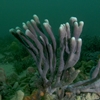General Description
A sandy-yellow sponge species, flabelliform to irregular form. Size of about 30 cm.
Biology
These sponges typically exude copious amounts of thick mucus when handled. The cortex of these sponges is armoured due to incorporation of sand into the outer layer of the skeleton.
Habitat
Reef areas, at depths of 3-30 m.
Sponge gardens
Reefs
Distribution guide
Port Phillip in Victoria.
Species Group
Depth
Water Column
Max Size
30 cm
Diet
Plankton or particles
Commercial Species
No
Global Dispersal
Recorded in Australia
Species Code
sp. MoV 6713
Identify
Conservation Status
- DSE Advisory List : Not listed
- EPBC Act 1999 : Not listed
- IUCN Red List : Not listed







